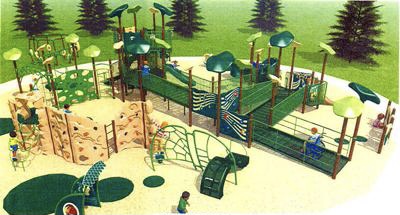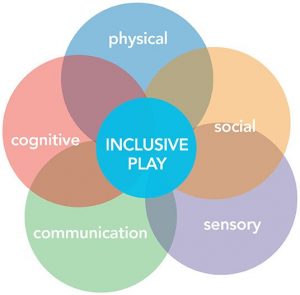Blog
Why Playgrounds Need To Be Accessible & Inclusive To All
Think back to some of your favorite childhood memories. Reflect on some of the first friendships you ever made. If your childhood was anything like mine, you will find that some of the most cherished moments of your upbringing took place when playing outside with siblings, neighbors, and friends. Many times, memories were made on the playground. Unfortunately for many who have a disability, visiting a playground is unrealistic due to it’s inaccessibility and failure to be inclusive to all.
According to Miracle Recreation, an organization that has been innovating playgrounds across the nation for nearly 100 years, “Playing at the playground is an essential part of childhood. It helps kids get the physical exercise they need to stay healthy, and it helps them develop critical cognitive, emotional, and social skills.” Acquiring these skills is important for every child – and it is time for every playground in our country to become both accessible and inclusive to all!
What Makes a Playground Accessible & Inclusive?
The 2010 ADA (Americans with Disabilities Act) Standard states that any playgrounds constructed or altered on, or after, March 15th, 2012 must follow 2010 ADA guidelines for accessible playgrounds. These guidelines are:
- There must be an accessible path from the building or parking area to the edge of the play area.
- There must be an accessible path from the edge of the play area to the equipment.
- Once someone is in the play area, they must be able to access the play equipment by either moving their mobility device onto the playground structure (such as a transfer station), or direct play structure in their mobility device (such as a ramp).
While at first thought one may think that every playground has been altered in the past ten years to fit modern playground standards – the truth is that many playgrounds have remained unchanged for decades. Some reasons why a playground may remain unchanged for decades include: unrealistically high expectations from a town or city’s government when it comes to how much money or effort it would take to make it accessible, the feeling that a playground is accessible enough because someone in a wheelchair could get from the parking lot to the edge of the play area while failing to consider other needs that person in a wheelchair has or the needs of people who experience other disabilities, and the ableist mindset that someone who has a disability would be unable to thrive and have fun in a playground in the same way others do. In reality – your local playground may just need a small modification to go from inaccessible and exclusive to accessible and inclusive.

Here are some ways a playground can be enhanced to meet the needs of all:
- Installing ground-level equipment. Those who are missing limbs or are on crutches may be unable to climb, run, or jump.
- Include equipment and objects that allow participants to assemble objects, align objects, put items in a pattern, or turn wheels. Add cozy spaces such as domes with space underneath it. While playgrounds are typically viewed as a place where there is lots of noise – some children with sensory conditions, or those on the autism spectrum may find it comforting and safe to be in a space with less noise. If you are considering adding a dome, or other piece of equipment onto your playground that would block out noise – make sure you are putting it in a space away from high-traffic equipment.
- Include textured surfaces and features that allow them to make sounds or music. Many times – people with audio or visual impairments benefit from these features because it makes them feel comfortable.
- Keep in mind that a parent or other adult may have a disability. Including areas where adults can sit and supervise their child is important when it comes to making that playground accessible.
- Make sure any signs or instructions are easy to read or interpret. Pictures and symbols that explain how equipment is meant to be used is important! Having a clear sense of how equipment is supposed to work is important for ALL!
The above information comes from https://www.accessibleplayground.net/ and www.miracle-recreation.com, websites dedicated to promoting and educating everyone about playground accessibility!
The Difference Between Accessibility & Inclusion
While the terms ‘accessible’ and ‘inclusive’ are often used in the same sentence – their meaning is not the same. According to Youth.gov, disability inclusion means “individuals with disabilities have the opportunity to participate in every aspect of life to the fullest extent possible. These opportunities include participation in education, employment, public health programming, community living, and service learning. Including people with disabilities in everyday activities and encouraging them to have roles similar to their peers who do not have a disability is important for building the capacity of youth, especially youth with disabilities, and making society more inclusive for all individuals.” While it is important for playgrounds to be inclusive and encourage those with and without disabilities to play together and become friends – a playground must be more than just inclusive in order for everyone to thrive.
The same website describes accessibility as “a place, environment, or event that is set up from the start to be accessible to all individuals.” Accessibility can take form in terms of places to enter and exit an area, visual and non-visual formats when presenting information, lighting, transportation, and access to quiet spaces.
Another term often used when discussing accessibility is ‘accommodation’. This term means “a change that is made so that a person with a disability is able to fully participate”. To some extent, there will always be the need for accommodations, but many advocates of those who have disabilities hope that with more focus on universal design and pushes to create “accessibility” from the start. Some who have a disability may feel awkward or as if they are being rude if they ask for too many accommodations – even when those accommodations are perfectly reasonable. If a playground is accessible, someone with a disability won’t have to bring their own equipment or ask for accommodations.

Accessible Playgrounds Near YOU!
Some playgrounds in our area that are accessible include:
Legacy Playground (Nashua, NH)
Crotched Mountain Treehouse (Greenfield, NH)
Rochester Common (Rochester, NH)
Casey White Playground (Manchester, NH)
Twin Bridge Park (Merrimack, NH)
Selvoski Park Playground (Bedford)
Many of the playgrounds in Concord, NH have accessibility features included. In Massachusetts, there are many more accessible playgrounds and you can check them out here: https://www.accessibleplayground.net/united-states/massachusett/
Is your town on the list? Maybe you can participate in advocacy efforts to add accessible conversion to your town’s planning. In the coming years – I look forward to seeing more towns and cities in New Hampshire and beyond recognize that playgrounds positively impact a child’s physical wellbeing, social and emotional skills, and cognitive functions, and with those realizations – make their playgrounds accessible to all! Visiting a playground should not be a luxury, playgrounds should be a place that anyone can visit and enjoy.